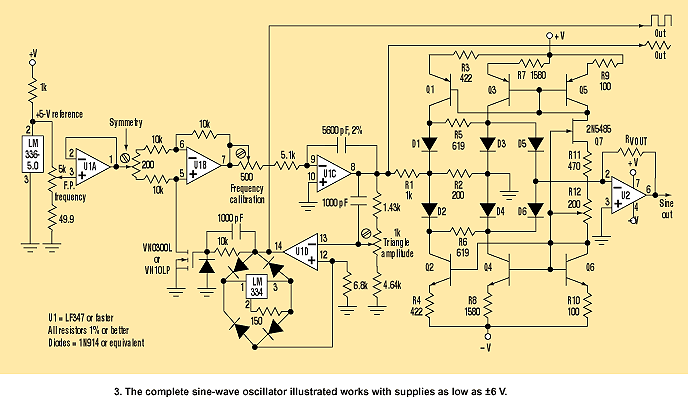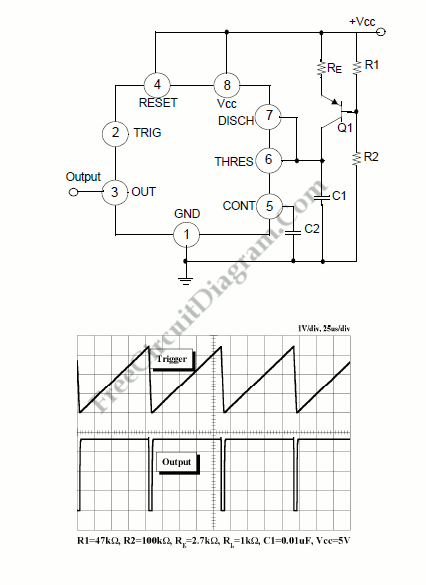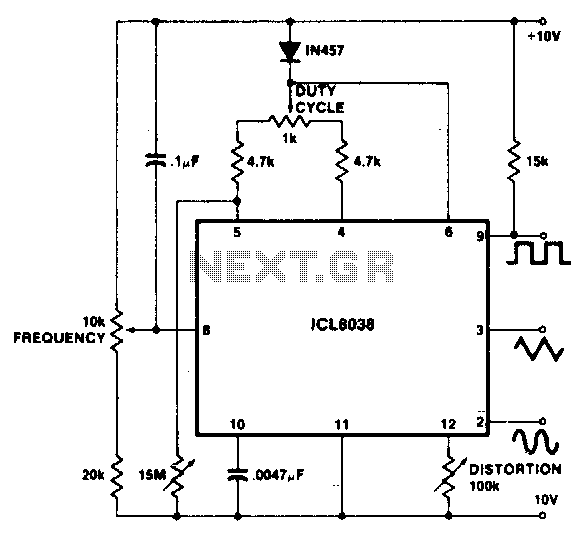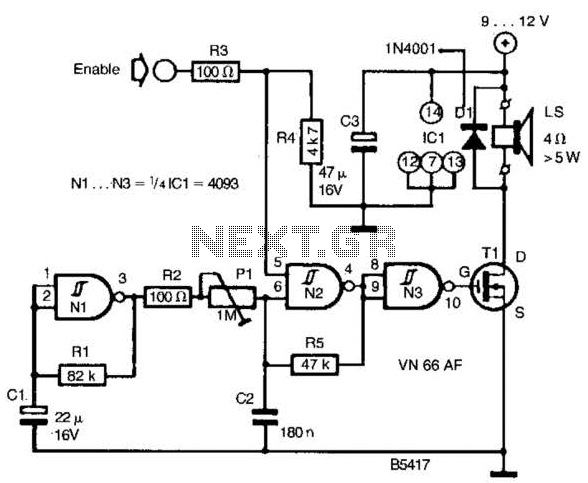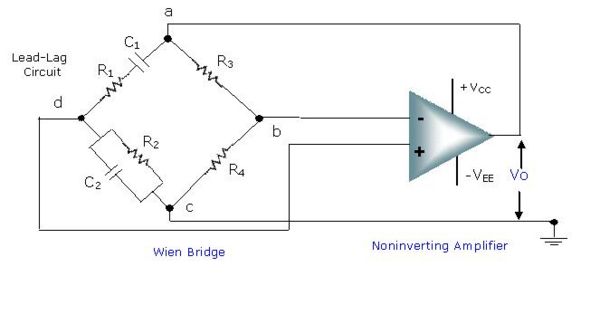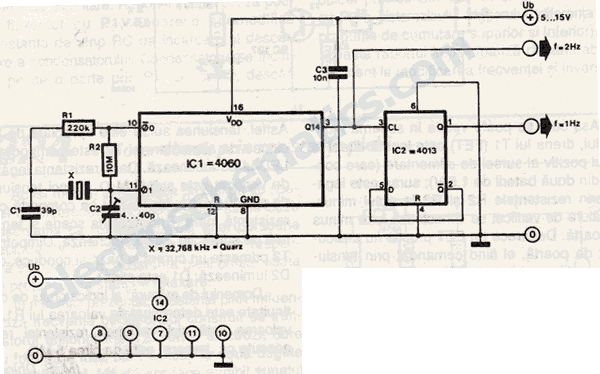
Crystal Oscillator - Parallel Resonant
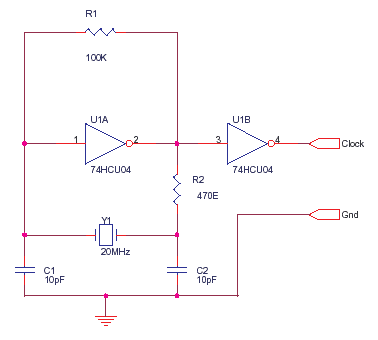
The 74HCU04 is a chip designed for specific circuit applications, while the HCT variant may not be suitable for such configurations. Capacitors C1 and C2 can be utilized up to 33pF, and resistor R2 can be adjusted to achieve the desired time constant by ensuring that R2 multiplied by C2 equals t. The circuit described is a parallel resonant oscillator circuit. The crystal operates based on the piezoelectric principle, where piezo refers to pressure. The application of an electric field alters the impedance of the crystal. Conversely, the needle of a vinyl record player exemplifies the reverse effect; the irregularities on the spiral groove of the record exert pressure on the needle, generating electricity. Both phenomena are manifestations of piezoelectric effects.
The 74HCU04 is a hex inverter chip that can be effectively used in various digital circuits, particularly in oscillator configurations. It is important to note that the HCT version, while similar, may not perform adequately in certain applications due to differences in voltage levels and input characteristics.
In the parallel resonant oscillator circuit, the capacitors C1 and C2 play a crucial role in determining the frequency of oscillation. The maximum capacitance of 33pF for these capacitors allows for fine-tuning of the circuit's resonant frequency. The resistor R2, which can be increased, is essential for setting the time constant of the oscillator. The relationship R2 * C2 = t (where t represents the time constant) is fundamental in ensuring that the oscillator operates within the desired frequency range.
The crystal utilized in this circuit operates on the piezoelectric principle, which is a phenomenon where certain materials generate an electric charge in response to applied mechanical stress. This is significant in oscillator circuits, as the crystal's impedance changes with the application of an electric field, allowing for stable oscillation at a specific frequency.
In contrast, the operation of a vinyl record player needle demonstrates the reverse piezoelectric effect. The needle, when placed on the record, experiences mechanical pressure from the grooves, which induces an electrical signal. This interaction highlights the versatility of piezoelectric materials and their applications in both generating and detecting electrical signals.
The design and implementation of this parallel resonant oscillator circuit can be further explored through resources on fundamental crystal oscillators and crystal oscillator circuits. For inquiries regarding content or copyright issues, communication can be directed to the provided email address within the specified timeframe.74HCU04 is a chip that was made for this purpose, HCT may not work for such a circuit. C1 and C2 can go to upto 33pF and R2 can be increased to make R2 * C2 = t. The circuit above is a parallel resonant oscillator circuit. The Crystal works by the piezoelectric principle, piezo means pressure. The electric field causes the impedance of the crystal to change. The LP Record Player needle is the reverse of this, the bumps on the spiral groove of the record applies pressure to needle which generates electricity. Both are piezo-electric effects. see more at Introduction to Fundamental Crystal Oscillators. see more at Crystal oscillator Circuits. We aim to transmit more information by carrying articles. Please send us an E-mail to wanghuali@hqew. net within 15 days if we are involved in the problems of article content, copyright or other problems.
We will delete it soon. 🔗 External reference
The 74HCU04 is a hex inverter chip that can be effectively used in various digital circuits, particularly in oscillator configurations. It is important to note that the HCT version, while similar, may not perform adequately in certain applications due to differences in voltage levels and input characteristics.
In the parallel resonant oscillator circuit, the capacitors C1 and C2 play a crucial role in determining the frequency of oscillation. The maximum capacitance of 33pF for these capacitors allows for fine-tuning of the circuit's resonant frequency. The resistor R2, which can be increased, is essential for setting the time constant of the oscillator. The relationship R2 * C2 = t (where t represents the time constant) is fundamental in ensuring that the oscillator operates within the desired frequency range.
The crystal utilized in this circuit operates on the piezoelectric principle, which is a phenomenon where certain materials generate an electric charge in response to applied mechanical stress. This is significant in oscillator circuits, as the crystal's impedance changes with the application of an electric field, allowing for stable oscillation at a specific frequency.
In contrast, the operation of a vinyl record player needle demonstrates the reverse piezoelectric effect. The needle, when placed on the record, experiences mechanical pressure from the grooves, which induces an electrical signal. This interaction highlights the versatility of piezoelectric materials and their applications in both generating and detecting electrical signals.
The design and implementation of this parallel resonant oscillator circuit can be further explored through resources on fundamental crystal oscillators and crystal oscillator circuits. For inquiries regarding content or copyright issues, communication can be directed to the provided email address within the specified timeframe.74HCU04 is a chip that was made for this purpose, HCT may not work for such a circuit. C1 and C2 can go to upto 33pF and R2 can be increased to make R2 * C2 = t. The circuit above is a parallel resonant oscillator circuit. The Crystal works by the piezoelectric principle, piezo means pressure. The electric field causes the impedance of the crystal to change. The LP Record Player needle is the reverse of this, the bumps on the spiral groove of the record applies pressure to needle which generates electricity. Both are piezo-electric effects. see more at Introduction to Fundamental Crystal Oscillators. see more at Crystal oscillator Circuits. We aim to transmit more information by carrying articles. Please send us an E-mail to wanghuali@hqew. net within 15 days if we are involved in the problems of article content, copyright or other problems.
We will delete it soon. 🔗 External reference
